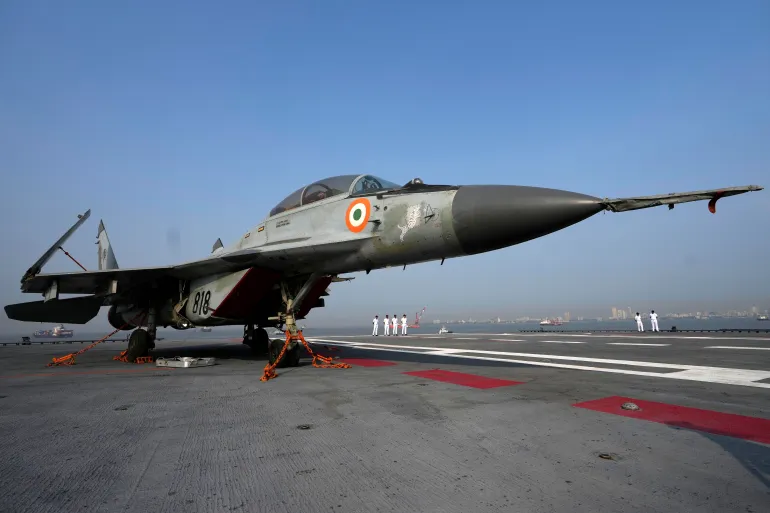When Indian Minister of Defence Rajnath Singh visited the Indian Navy’s aircraft carrier INS Vikrant on May 30, nearly three weeks after a ceasefire was announced with Pakistan after a four-day conflict, he had stern words for Islamabad.
Wearing an Indian Navy baseball cap, with his initial “R” emblazoned on it, Singh declared that Pakistan was fortunate the Indian Navy had not been called upon during the recent hostilities..
“Despite remaining silent, the Indian Navy succeeded in tying down the Pakistani Army. Just imagine what will happen when someone who can keep a country’s army locked in a bottle, even by remaining silent, speaks up?” Singh said, standing in front of a Russian-made MiG-29 fighter jet on the deck of the 262-metre-long (860 feet) ship.
Just two days later, on June 1, the Pakistan Navy issued a pointed response. In a message posted on X, it announced a two-day exercise, “focusing on countering sub-conventional and asymmetric threats across all major ports and harbours of Pakistan”.
These symbolic shows of strength followed India’s “Operation Sindoor” and Pakistan’s “Operation Bunyan Marsoos“, the countries’ respective codenames for the four-day conflict that ended in a ceasefire on May 10.
The standoff was triggered by an April 22 attack in Pahalgam, in Indian-administered Kashmir, in which 26 civilians, almost all tourists, were killed. India blamed armed groups allegedly backed by Pakistan, a charge Islamabad denied.
On May 7, India launched missile strikes at multiple sites in Pakistan’s Punjab province and Pakistan-administered Kashmir, killing at least 51 people, including 11 soldiers and several children. Over the next three days, the two countries exchanged artillery and air power, hitting each other’s airbases.
The 96 hours of conflict brought 1.6 billion people to the brink of war. But while the navies largely remained passive observers, they monitored each other’s movements – and were ready for action.
Satellite imagery showed that the INS Vikrant moved towards Pakistan soon after the Pahalgam attack and remained deployed for four days in the Arabian Sea before returning to its base in Karnataka.
Pakistan also mobilised its fleet, which was bolstered by the docking of a Turkish naval ship in Karachi on May 2. According to the Pakistani Navy, Turkish personnel engaged in “a series of professional interactions” with their counterparts.
Now, even amid the current pause in military tensions, analysts say Singh’s remarks and Pakistan’s naval drills highlight the growing part that maritime forces could play in the next chapter of their conflict. This is a role the Indian and Pakistani navies are well-versed in.
These saw no use during the first India-Pakistan war in 1947, over the contested Himalayan region of Kashmir. India and Pakistan both administer parts of Kashmir, along with China, which governs two thin strips. India claims all of Kashmir, while Pakistan claims all the parts not controlled by China, its ally.
By the 1965 war, also over Kashmir, Pakistan had expanded its fleet with aid from the United States and United Kingdom, its Cold War allies. It had acquired Ghazi, a long-range submarine, giving it an edge over India, which lacked a submarine at the time, though it owned an aircraft carrier. Pakistan, to date, does not have an aircraft carrier.
While the land war started on September 6, the Pakistan Navy joined the conflict on the night of September 7-8. A fleet of seven warships and submarine PNS Ghazi left Karachi harbour and made their way towards the Indian naval base of Dwarka in the western state of Gujarat, roughly 350km (217 miles) away.
They were tasked with carrying out the “bombardment of Dwarka about midnight using 50 rounds per ship”, according to the Pakistan Navy’s official account, targeting the base’s radar and other installations.
The selection of Dwarka was significant from a historical and strategic perspective. The city is home to one of the most sacred sites for Hindus, the Somnath Temple, on which the Pakistan Navy named its operation.
Militarily, the radar installations in Dwarka were used to provide guidance to the Indian Air Force. Knocking them out would have made it harder for India to launch aerial attacks against Pakistani cities, especially Karachi. That, in turn, would have forced India to send out its warships from the nearby port of Bombay (now Mumbai) – and PNS Ghazi, the submarine, could have ambushed them.
But the Pakistani plan only partly worked. Many Indian warships were under maintenance, and so the Indian Navy did not send them out to chase the Pakistani fleet.
According to the Pakistan Navy’s accounts, after firing about 350 rounds, the operation ended in “four minutes” and all its ships returned safely.
Syed Muhammad Obaidullah, a former commodore in the Pakistan Navy, recalled the attack.










